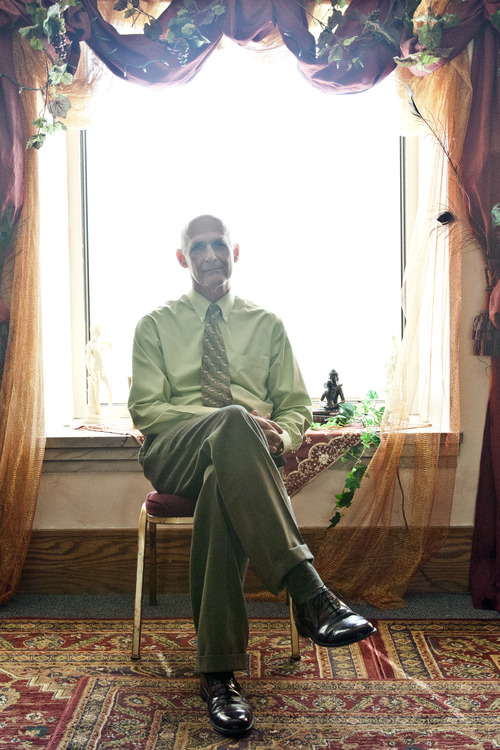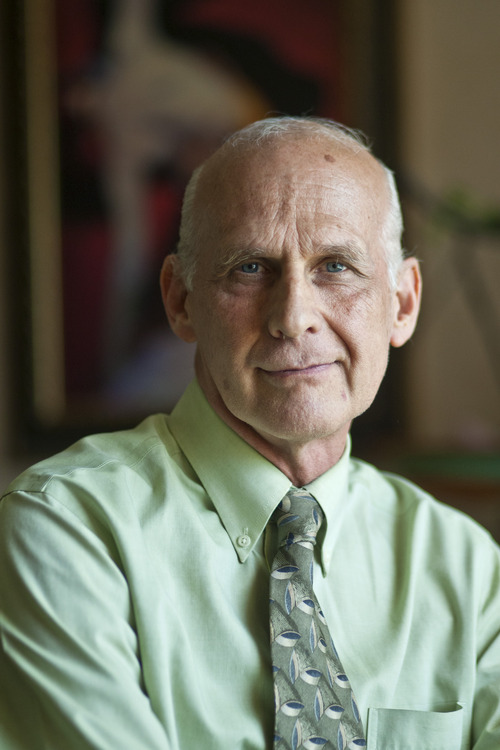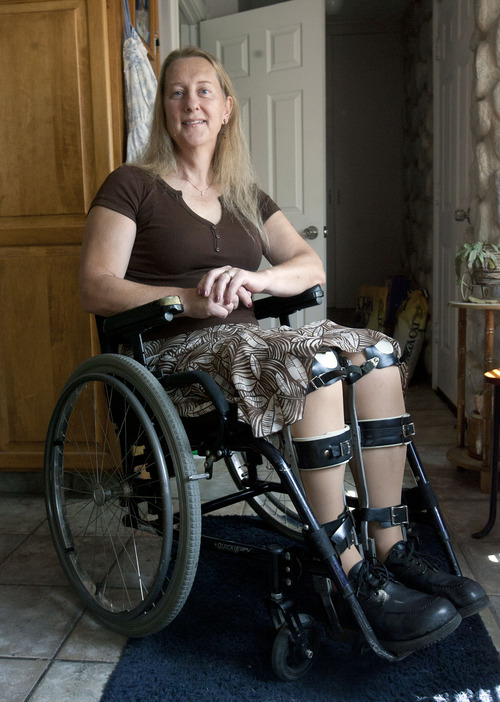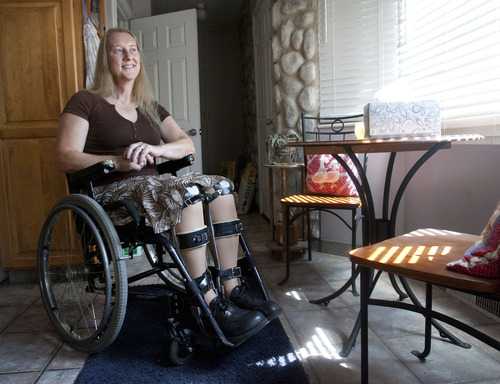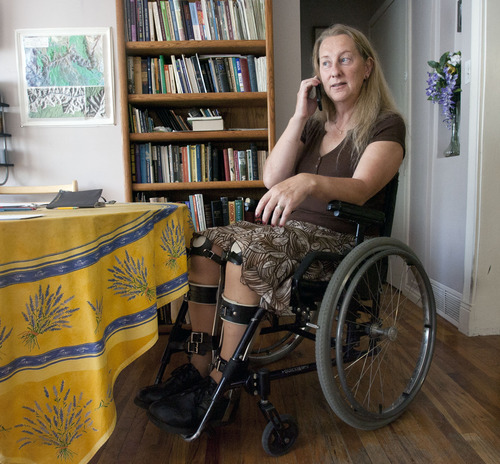This is an archived article that was published on sltrib.com in 2013, and information in the article may be outdated. It is provided only for personal research purposes and may not be reprinted.
She knows you probably don't get it. That's what motivates her to tell her story.
West Bountiful's Chloe Jennings-White has made international headlines for her desire to be paralyzed by a medical procedure, touching off a wide range of emotional reactions and ethical debates.
The 58-year-old research scientist on contract with the psychiatry department at University of Utah Hospital — where she has worked off and on since 1991 — earned a doctorate from Cambridge University and says she grasps the obvious: it's unusual to want to be disabled.
"How can a completely sane person want to be paralyzed?" she says. "I'm not in any way delusional or anything, but still I'm aware that this is a strange thing for most people to wrap their minds around, including myself."
Body Integrity Identity Disorder, or BIID, is a rare condition in which people feel that one or more limbs are not meant to be a part of their body, and they'd prefer to be a paraplegic or an amputee.
Those with BIID often reject all interventions — such as psychotherapy — short of amputation or paralysis, and news archives are replete with examples of botched home amputations leading, sometimes, to death.
A community of people with BIID has gathered on Internet websites, particularly after the disorder was given its name by Columbia University psychiatrist Michael First in 2005. It is not officially recognized in the Diagnostic and Statistical Manual of Mental Disorders, the standard for mental health professionals.
It was First who diagnosed Jennings-White, she says, after a three-hour phone conversation in 2008. He suggested that she begin using a wheelchair and that she no longer keep her condition secret.
The causes of BIID are not clear. While some researchers think it is a mental disorder akin to gender identity disorder or anorexia, some also think there may be neurological causes having to do with the way the brain maps the body.
In any case, stories like Jennings-White's often trigger an angry — if somewhat conflicted — response from people who are paralyzed or amputees through no choice of their own.
"I feel for her. It must be terrible to feel that way in your own body," says Bob Vogel, who was paralyzed in a skiing accident 28 years ago and now writes for "New Mobility Magazine." He blogged about Jennings-White in 2012 on another website.
And yet, he doesn't like the misinformation he believes is conveyed in the stories he watches or reads. "Her message seems to really muddy the waters of what it means to be paralyzed."
She has been photographed loading her own wheelchair into a car trunk and adjusting her leg braces so they'll bend at the knee when she walks up stairs.
Using a wheelchair or leg braces is the easiest of all the challenges, he says. Preventing sores, dealing with the loss of bladder and bowel control and dealing with neurological pain are much more difficult.
"How convenient that she's choosing to have the easiest type of paralysis," says Vogel, who lives in northern California.
To deliberately paralyze oneself, he says, "is just barbaric. Nobody should ever have that done. She should never have her spinal cord cut."
—
'My ideal body image' • Jennings-White knew for years that she was drawn to paralysis, but a December 2006 skiing accident made the longing more intense.
She hit a buried tree stump and dropped 5 or 6 feet while on a single-diamond black run. The shock of the impact caused bruising and swelling in her spinal cord and partial paralysis in her upper left leg.
"For some reason that I haven't fully grasped yet, that massively intensified my BIID, and I realized that I needed to do something about it, because it was intense and distracting," she says.
She acknowledges the coincidence that someone yearning for paralysis would happen to suffer such an injury instead of, say, a broken leg. But she believes the injury was genuine, if perhaps influenced by her brain's unusual wiring. Either way, in her mind, the paralysis is a good thing.
"If I touch my left thigh with my hand, I don't feel it, and that feels right to me. It's like a part of my brain tells me that I'm not supposed to be able to move my legs or have sensation in them."
Mark Malan, an Ogden sexologist who works with Jennings-White on gender identity issues, says it's about identity. (Though she feels it did not play a role in her development of BIID, Jennings-White was born "intersex," with both male and female organs. While she was raised as a boy, she always felt she was female. Several years ago, she had gender reassignment surgery, and she credits the experience with helping her cope with BIID.)
People with the disorder have formed positive associations to a disabled body, Malan says. "They are thinking, 'If I was disabled in some way or lost a limb, that would be my ideal body image.'"
Born and raised in London, Jennings-White says she first recognized her unusual feelings at age 4, when she saw her Aunt Olive wearing leg braces after a cycling accident. She doesn't believe, as Malan suspects, that it was any special attachment to her aunt that caused BIID; rather, she thinks seeing the leg braces helped her to define a pre-existing inclination.
By 9, she was cycling recklessly in the hopes of wrecking and becoming paraplegic — not purposely injuring herself, but "tempting fate," she says. Her parents began to leave her alone for longer stretches at age 10, and she would bandage her legs while they were away.
Her 2006 injury finally gave her an excuse to purchase her long-sought leg braces, and it was during her online research that she first learned about BIID. She had married her wife, Danielle, by then, using a document that identified Jennings-White as male. Danielle was happy that her frugal spouse found something to splurge on, but … leg braces?
"Eventually it came up as a discussion between us — why do I really want these leg braces? I said, 'What I really want is to physically need these leg braces.' Like anybody else, for the first time, she had a little difficulty bending her mind around it, but she is by far my biggest supporter at this point."
Longtime friend Jaime Hartzell, 48, of Price, was paralyzed in 1985 when the ATV he was driving went over a bridge and he fell more than 50 feet.
"I would give anything to be able to walk again," Hartzell says. "[Jennings-White's condition] is a little frustrating for me, but I'm not in her situation, so I can't judge her."
He's answered many questions from her and warned her about complications that accompany spinal cord injuries, including life-threatening bladder infections, blood clots and bowel problems. She'd also have to move out of her multi-story home, and she would no longer be able to visit her friends at will. And she may still have problems with the disorder, he notes.
But if Jennings-White determines that relief from her mental stress is worth the consequences, he says, that's her decision to make.
"She's super compassionate, she's open-minded, she's intelligent, and I just would not want to see any of that lessened or diminished because of a decision that she made based on curiosity," he says.
"I think on some level that I'm actually envious of Chloe," Hartzell says. "Just for the fact that she could go in and fix her problem with this surgery, whereas I am unable to fix my paralysis."
—
'Is there buyer's remorse?' • In 2007 Jennings-White started telling close friends and her psychotherapist, who agreed that she had nothing to be ashamed about and that if her friends were going to love her, they'd have to love her for who she is.
To raise awareness of the condition, Jennings-White began appearing on televised shows such as "Taboo" on the National Geographic Channel and Anderson Cooper's CNN show.
But her campaign raised an ethical dilemma: The power of her suggestion might lead to BIID in others. Jennings-White rejects that notion.
"What I'm hearing from people contacting me is that they have known this about themselves since they were very young, and they found out about BIID for the first time through the publicity that I've been getting, and they expressed their relief and gratitude to know that they are not alone," she says
The procedure Jennings-White wants is called a nerve transection, in which a surgeon would sever the sciatic and femoral nerves that go to her left leg and create the sensation of paralysis.
"I guess I'm kind of conservative in the sense of not wanting to make myself any more disabled than is absolutely necessary for my sense of well-being," she says.
But she has found just one taker — an overseas doctor who she declined to identify — who wants $25,000 for the procedure. She balked at the cost, and says that even if she had the money she'd probably first buy better hearing aids to resolve a congenital disorder. She concedes she hasn't looked hard for cheaper options, dissuaded by talk in BIID forums about the difficulty of finding a doctor willing to do the procedure.
Medications have "zero effect" and therapy has not stopped her desire, Jennings-White says.
Jeffrey Botkin, chief of medical ethics at the University of Utah School of Medicine, says it is ethical rather than legal barriers that likely keep surgeons from agreeing to amputate or disable healthy limbs — although there may be some fear of malpractice lawsuits.
Just because a patient wants something doesn't mean it's good for him or her. Not every request for drugs is honored, for instance.
"Clinicians are on very solid grounds in refusing to participate if they think it's not consistent with the patient's welfare," he said.
Before agreeing to deliberately deform a patient, a physician would have to ensure the desire wasn't a manifestation of a psychiatric disease, Botkin says. And he or she would want to look at the research, he says.
"Do people, in fact, end up being happy?" he asks. "Or is there buyer's remorse?"
He adds: "I don't think there's good justification for that kind of intervention except in the most unusual situation."
Jennings-White counters that it's no different from plastic surgery or gender reassignment surgery.
"Society seems to have some double standards regarding what kind of body modifications are OK," she says.
"If someone wants larger breasts, then that's their decision, and if someone wants their left leg paralyzed, that's also their decision."
Malan applauds her for trying to raise public awareness, but he is undecided whether he would endorse a surgery to make her permanently paralyzed. Perhaps, instead, a surgeon could use a temporary nerve block so she could experience the sensation of paralysis, he said. Jennings-White says most doctors aren't willing to do that, either.
Jennings-White acknowledges that critics are right to point out that she doesn't understand what it's like to be paralyzed. "…Likewise, they don't understand what it's like to have BIID," she says.
She says the majority of her friends have physical disabilities and she talks with them frequently about what it's like to be paralyzed.
"At this point, that's as close as I can get," she says. "I certainly know all the factual stuff about it. … But that is a good point that I don't know what it feels like."
Twitter: @matthew_piper
Twitter: @kristenmoulton



